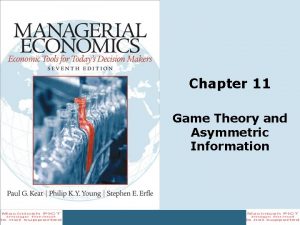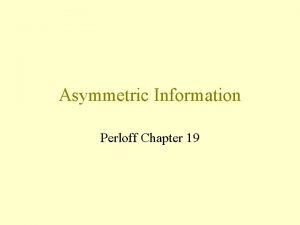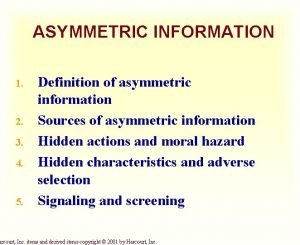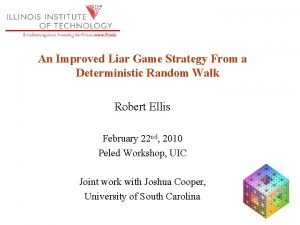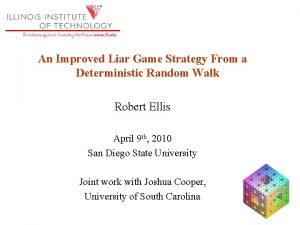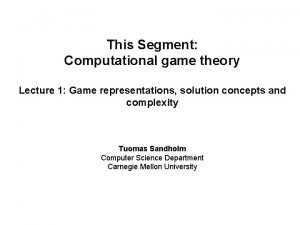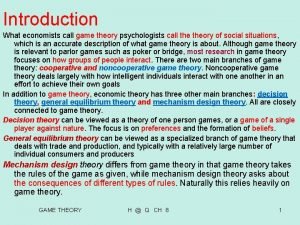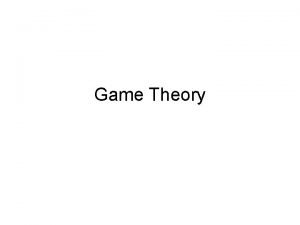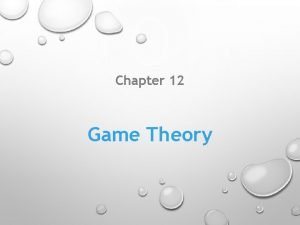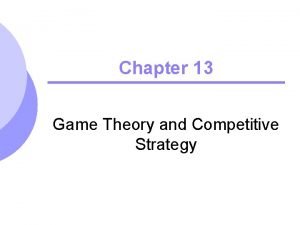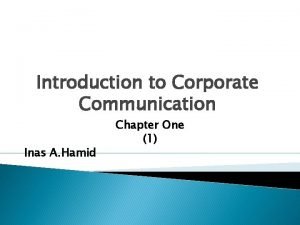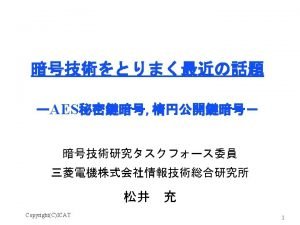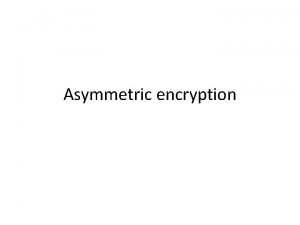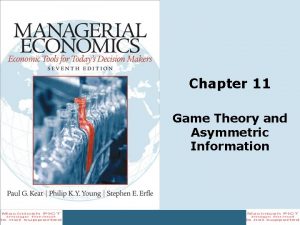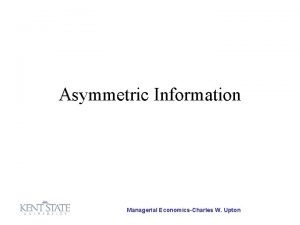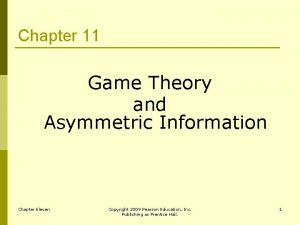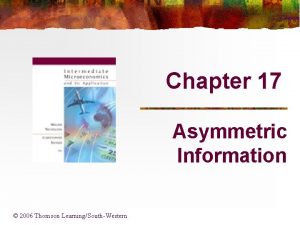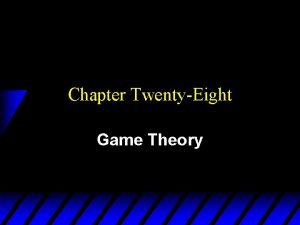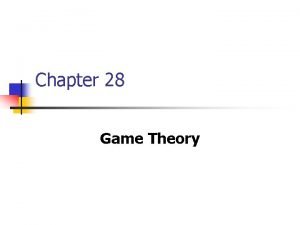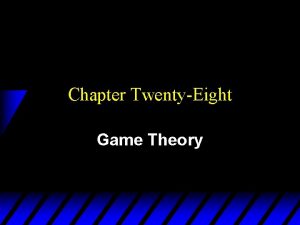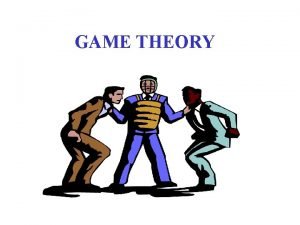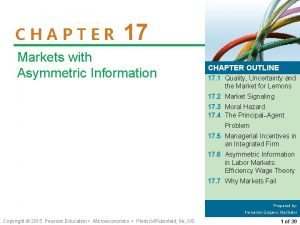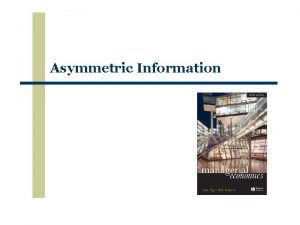Chapter 11 Game Theory and Asymmetric Information Outline


























- Slides: 26

Chapter 11 Game Theory and Asymmetric Information

Outline • Game theory – Game theory and management decisions – Strategy and game theory • Asymmetric information – Reputation – Standardization – Market signaling Copyright © 2014 Pearson Education, Inc. All rights reserved. 11 -2

Learning Objectives • Define game theory and explain how it helps better understand mutually interdependent management decisions • Explain the game called Prisoners’ Dilemma and its application to business • Explain the difference between cooperative and non -cooperative games • Show bargaining tactics and focal points affect business decisions Copyright © 2014 Pearson Education, Inc. All rights reserved. 11 -3

Learning Objectives • Explain ‘asymmetric information’ and its affect on markets • Describe the concepts of ‘adverse selection’ and ‘moral hazard’ • Explain how ‘market signaling’ can help agents make better economic decisions when asymmetric information exists Copyright © 2014 Pearson Education, Inc. All rights reserved. 11 -4

Game Theory Economic optimization has two shortcomings when applied to actual business situations – assumes factors such as reaction of competitors or tastes and preferences of consumers remain constant – managers sometimes make decisions when other parties have more information about market conditions Copyright © 2014 Pearson Education, Inc. All rights reserved. 11 -5

Game Theory Game theory is used by economists to examine strategic interaction of markets, and is especially useful in analyzing oligopoly markets. – A game involves players making strategic decisions – Players are the decision-making units – A strategy is an option available to a player – Payoffs are the outcomes Copyright © 2014 Pearson Education, Inc. All rights reserved. 11 -6

Game Theory • Fundamental aspects of game theory – players are interdependent – uncertainty: other players’ actions are not entirely predictable • Types of games – zero-sum or non-zero-sum – cooperative or non-cooperative – two-person or n-person Copyright © 2014 Pearson Education, Inc. All rights reserved. 11 -7

Game Theory • A payoff matrix is a table that describes the outcome for each player and for each set of strategic choices. • A dominant strategy (DS) is a strategy that produces the optimal outcome regardless of what the other players do. • A dominant strategy equilibrium (DSE) occurs if each player in a game chooses its dominant strategy. • A Nash equilibrium occurs if every player’s strategy is optimal given its competitors’ strategies. Copyright © 2014 Pearson Education, Inc. All rights reserved. 11 -8

Games in Economics Example: The nightclub game Decision: Live band or DJ? Copyright © 2014 Pearson Education, Inc. All rights reserved. 11 -9

Games in Economics Prisoners’ Dilemma • two-person, non-zerosum, non-cooperative • always has a dominant strategy • equilibrium is stable • confessing is the dominant strategy for each player, no matter what other player chooses • each player has no incentive to unilaterally change his strategy Copyright © 2014 Pearson Education, Inc. All rights reserved. 11 -10

Games in Economics • Repeated Game: game is played repeatedly over a period of time • In a perpetual repeated game, equilibria that are not stable may become stable due to the threat of retaliation. • However, if number of periods is fixed, players will have incentive to ‘cheat’ in the last period due to lack of threat of retaliation, which will then allow them to cheat in all periods. Copyright © 2014 Pearson Education, Inc. All rights reserved. 11 -11

Games in Economics • Simultaneous games are games in which players make their strategy choices at the same time • Sequential games are games in which players make their decisions sequentially – In sequential games, the first mover may have an advantage Copyright © 2014 Pearson Education, Inc. All rights reserved. 11 -12

Bargaining • A cooperative game is a game in which the players can negotiate explicit binding contracts. • A zero sum game is a game where the sum of payouts is constant. • A variable sum game is a game where the sum of payouts for each set of strategies varies. Copyright © 2014 Pearson Education, Inc. All rights reserved. 11 -13

Bargaining Game Tactics • A non-cooperative game is a game in which formal negotiation and entering into a legally binding contract is not possible. • Tacit bargaining is bargaining that is not openly expressed but is implied by actions. • Focal points are points chosen due to their prominence (i. e. make the “obvious” choice-the one that is favorable to you). Copyright © 2014 Pearson Education, Inc. All rights reserved. 11 -14

Bargaining More Game Tactics • A threat is undertaking an action that harms yourself if your rival does something you do not want your rival to do. You make yourself worse off • A promise is a commitment to a second party in a bargain Copyright © 2014 Pearson Education, Inc. All rights reserved. 11 -15

Bargaining Another Game Tactic • The use of limited war – The feature of war that makes it limited is that the bounds are qualitative, not quantitative, in nature. – Example in oligopoly behavior--should the firm restrict competition to non-price dimensions and avoid price competition? Copyright © 2014 Pearson Education, Inc. All rights reserved. 11 -16

Bargaining • General Framework of Game Play – P. A. R. T. S. • • • Players Added value Rules Tactics Scope Copyright © 2014 Pearson Education, Inc. All rights reserved. 11 -17

Asymmetric Information Asymmetric information: market situation in which one party in a transaction has more information than the other party. Leads to many problems in markets: – too much or too little production – difficult contracting – possible fraud – market may disappear Copyright © 2014 Pearson Education, Inc. All rights reserved. 11 -18

Asymmetric Information Problems with Asymmetric Information 1. Adverse selection: prior to transaction, one party may know more about the value of a good than the other – Possible ways to reduce adverse selection: imposition of a government edict requiring all to purchase insurance, or screening by insurance companies. Copyright © 2014 Pearson Education, Inc. All rights reserved. 11 -19

Asymmetric Information 2. Moral hazard: transaction changes the incentives of a party because it cannot be monitored after the transaction. 3. Principal-agent problem: occurs when the principal (usually the owner of the firm) cannot monitor the actions of the agent. • The principal-agent problem can be reduced by the appropriate choice of a managerial compensation package Copyright © 2014 Pearson Education, Inc. All rights reserved. 11 -20

Asymmetric Information Market responses: • • obtaining information from third parties relying on reputation of the seller standardization of products market signaling: demonstrated success in one activity provides information about success/quality in another Copyright © 2014 Pearson Education, Inc. All rights reserved. 11 -21

Asymmetric Information • Example – Adverse selection – ‘lemons’ (bad used cars): seller knows the vehicle well, but buyer does not Copyright © 2014 Pearson Education, Inc. All rights reserved. 11 -22

Asymmetric Information • Example: education as a signal – attending college demonstrates certain traits – employers see this as a screening device Copyright © 2014 Pearson Education, Inc. All rights reserved. 11 -23

Asymmetric Information • Example: warranties – more costly on low quality goods than high quality goods – consumers see them as a screening device Copyright © 2014 Pearson Education, Inc. All rights reserved. 11 -24

Summary • Oligopolistic interaction can be modeled using game theory. • The outcome, or payout, depends not only an individual player’s strategy but also on strategy of the rival player. • Bargaining is negotiating over the terms of an agreement. • Bargaining can be explicit and enforceable, or it can be tacit and formally unenforceable. Copyright © 2014 Pearson Education, Inc. All rights reserved. 11 -25

Summary • An informational asymmetry exists when one side knows more than the other in a transaction. • Education acts as a separating (or signaling) device in hiring workers. • Adverse selection and moral hazard arise due to information asymmetries. • The principal-agent problem occurs when the principal cannot monitor the actions of the agent. Copyright © 2014 Pearson Education, Inc. All rights reserved. 11 -26
 Game theory asymmetric information
Game theory asymmetric information Asymmetric information diagram
Asymmetric information diagram Asymmetric information diagram
Asymmetric information diagram Pirate game grid
Pirate game grid Game lab game theory
Game lab game theory Liar game game theory
Liar game game theory Liar game game theory
Liar game game theory Game theory and graph theory
Game theory and graph theory Symmetric and asymmetric matrix
Symmetric and asymmetric matrix Evidence sandwich example
Evidence sandwich example Information sets in game theory
Information sets in game theory Information sets in game theory
Information sets in game theory Information sets in game theory
Information sets in game theory Information sets in game theory
Information sets in game theory Information sets in game theory
Information sets in game theory Chapter 13 game theory and competitive strategy
Chapter 13 game theory and competitive strategy Advantages of asymmetric encryption
Advantages of asymmetric encryption Asymmetric communication
Asymmetric communication Asymmetric iugr babies
Asymmetric iugr babies Asymmetric vlan
Asymmetric vlan Asymmetric communication
Asymmetric communication Vlan table
Vlan table Define ihrm
Define ihrm Des aes
Des aes Ccna vlan
Ccna vlan Asymmetric vlan
Asymmetric vlan Key distribution
Key distribution
